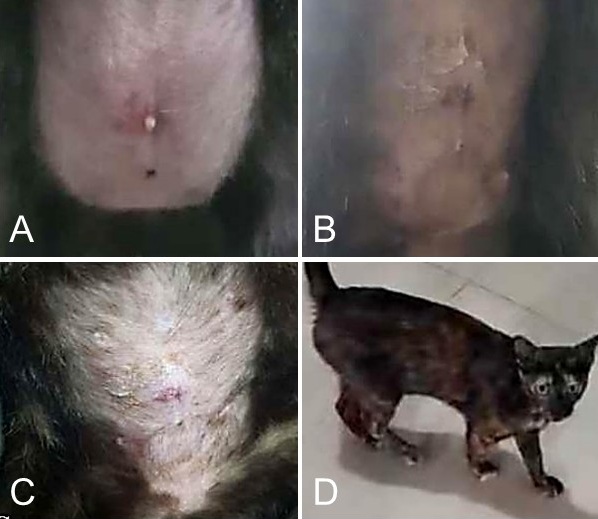Effective resolution of a post-ovariohysterectomy cutaneous abscess in a young female cat following antibiotic switch from amoxicillin to cefadroxil
Abstract
This case report presents the first use of buried continuous intradermal sutures in Indonesia to treat a post-ovariohysterectomy cutaneous abscess in a young cat, with an antibiotic switch. A 6-month-old female cat, K (2.5 kg), developed a cutaneous abscess after ovariohysterectomy. Amoxicillin trihydrate (15 mg/kg q12h) was administered orally for postoperative antimicrobial therapy. On day 9, physical examination revealed swelling at the sutured incision site, an elevated rectal temperature (39.9°C), and a grimacing expression. Antibiotic therapy was continued with subcutaneous injection of long-acting amoxicillin (15 mg/kg). However, by day 18, the owner reported purulent discharge from the swollen area. Upon re-examination, the antibiotic regimen was adjusted by replacing amoxicillin trihydrate with cefadroxil (35 mg/kg q24h, orally). By day 21, significant healing was observed with a notable reduction in abscess size and complete cessation of pus discharge. In subsequent days, clinical signs gradually diminished, and K's overall condition improved, as indicated by the return of normal appetite, behavior, and activity. The sutured incision site healed well and blended seamlessly with the surrounding skin.
Downloads
References
Chutipongvivate P, Lampang KN, Punyapornwithaya V, Thongkorn K. 2022. Incidence of short-term complications after sterilization between pre-operative antibiotic versus pre- and post-operative antibiotic administration in female cats. Veterinary Integrative Science. 20(1):379-389. https://doi.org/10.12982/VIS.2022.028
Devriendt N, Mortier F, de Rooster H. 2023. Antimicrobial prophylaxix in canine and feline surgery. Vlaams Diergeneeskundig Tijdschrift. 92(3):131-141. https://doi.org/10.21825/vdt.87487
Gates MC, Littlewood KE, Kongara K, Odom TF, Sawicki RK. 2020. Cross-sectional survey of surgical techniques used to perform dog and cat spays in New Zealand veterinary practice. New Zealand Veterinary Journal. 68(1):46-53. https://doi.org/10.1080/00480169.2019.1665594 | PMid:31510881
Koch SN, Torres SMF, Plumb DC. 2012. Canine and Feline Dermatology Drug Handbook. Wiley-Blackwell. https://doi.org/10.1002/9781118704745
Lopez DJ, Hayes GM, Fefer G, McCalla SA, LaLonde-Paul DF, Flanders JA, Sumner JP. 2020. Effect of subcutaneous closure technique on incisional complications and postoperative pain in cats undergoing midline celiotomy: A randomized, blinded, controlled trial. Veterinary Surgery. 49(2):321-328. https://doi.org/10.1111/vsu.13344 | PMid:31664719
Older CE, Diesel A, Patterson AP, Meason-Smith C, Johnson TJ, Man-sell J, Suchodolski JS, Rodrigues Hoffmann A. 2017. The feline skin microbiota: The bacteria inhabiting the skin of healthy and allergic cats. PLoS One. 12(6): e0178555. https://doi.org/10.1371/journal.pone.0178555 | PMid:28575016 PMCid:PMC5456077
Ouldamer L, Bonastre J, Brunet-Houdard S, Body G, Giraudeau B, Caille A. 2016. Dead space closure with quilting suture versus conventional closure with drainage for the prevention of seroma after mastectomy for breast cancer (QUISERMAS): protocol for a multicentre randomized controlled trial. BMJ Open. 6(4): e009903. https://doi.org/10.1136/bmjopen-2015-009903 | PMid:27044574 PMCid:PMC4823448
Papich MG. 2011. Saunders Handbook of Veterinary Drugs: Small and Large Animal. 3rd ed. Elsevier Saunders. Missouri.
Rabbani AH, Khan YR, Naseer O, Qudratullah, Safwan HM. 2021. Biocompatibility and postoperative complications of different sub-cutaneous suturing methods in cats undergoing ovariohysterectomy by midline incision. 2021. Thai Journal Veterinary Medicine. 51(3):577-585. https://doi.org/10.56808/2985-1130.3153
Ramsey I. 2011. BSAVA Small animal formulary. 7th ed. British small animal veterinary association. Gloucester.
Roy J, Messier S, Labrecque O, Cox WR. 2007. Clinical and in vitro efficacy of amoxicillin against bacteria associated with feline skin wounds and abscesses. The Canadian Veterinary Journal. 48(6):607-611.
Sørensen TM, Scahill K, Espinel Ruperez J, Olejnik M, Swinbourne F, Verwilghen DR, Nolff MC, Baines S, Marques C, Vilen A, et al. 2024. Antimicrobial prophylaxis in companion animal surgery: A scoping review for European network for optimization of antimicrobial therapy (ENOVAT) guidelines. The Veterinary Journal. 304(106101):1-10. https://doi.org/10.1016/j.tvjl.2024.106101 | PMid:38490359
Stavisky J, Brennan M. 2020. Comparing wound complications associated with midline and flank approaches for spaying cats. The Veterinary Record. 186(6):188-189. https://doi.org/10.1136/vr.m532 | PMid:32054805
Xin LY, Noviana D, Afiff U. 2024. Comparison of buried continuous intradermal and simple interrupted suture patterns for skin closure in feline ovariohysterectomy. ARSHI Veterinary Letters. 8(4):99-100. https://doi.org/10.29244/avl.8.4.99-100

Copyright (c) 2025 CC-BY-SA

This work is licensed under a Creative Commons Attribution-ShareAlike 4.0 International License.
Authors who publish with this journal agree to the following terms:
1. Authors retain copyright and grant the journal right of first publication with the work simultaneously licensed under a Creative Commons Attribution License that allows others to share the work with an acknowledgement of the work's authorship and initial publication in this journal.
2. Authors are able to enter into separate, additional contractual arrangements for the non-exclusive distribution of the journal's published version of the work (e.g., post it to an institutional repository or publish it in a book), with an acknowledgement of its initial publication in this journal.
3. Authors are permitted and encouraged to post their work online (e.g., in institutional repositories or on their website) prior to and during the submission process, as it can lead to productive exchanges, as well as earlier and greater citation of published work (See The Effect of Open Access).

.jpg)















